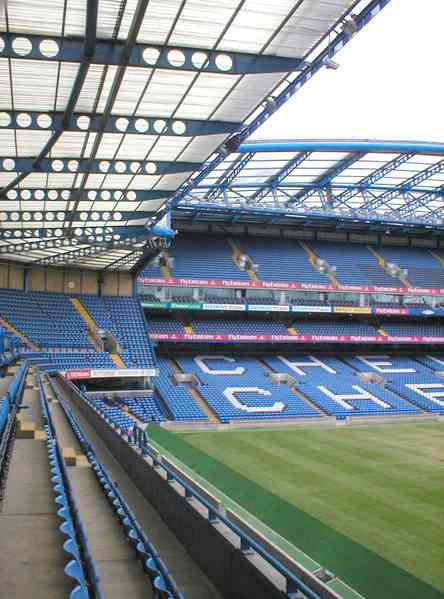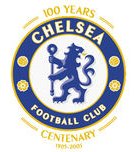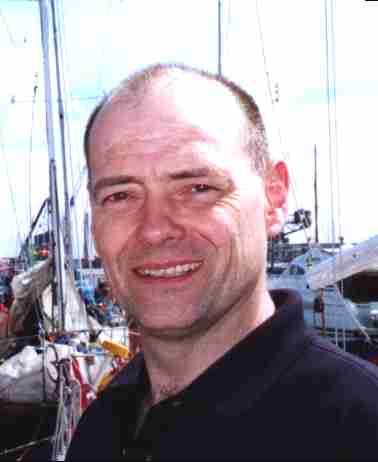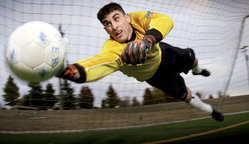|
CHELSEA FOOTBALL CLUB
|
|||||||||||||||||||||||||||||||||||||||||||||||||||||||||||||||||||||||||||||||||||||||||||||||||||||||||||||||||||||||||||||||||||||||||||||||||||||||||||
|
HOME | BIOLOGY | FILMS | GEOGRAPHY | HISTORY | INDEX | MUSIC | SOLAR BOATS | SPONSORS | SPORT |
|||||||||||||||||||||||||||||||||||||||||||||||||||||||||||||||||||||||||||||||||||||||||||||||||||||||||||||||||||||||||||||||||||||||||||||||||||||||||||
|
Chelsea Football Club (also known as the Blues, previously known as the Pensioners, a reference to the Chelsea pensioners), founded in 1905, is an English Premier League football team that plays at the Stamford Bridge football ground in south-west London. Chelsea are the reigning FA Premier League champions for the second year in a row.
Despite its name, the club is based just outside the Royal Borough of Kensington and Chelsea, in the London Borough of Hammersmith and Fulham. It is on the Fulham Road, which runs between Fulham and Chelsea.
Chelsea's home ground is Stamford Bridge, in London
Stamford Bridge
Unusually for a football club, Chelsea have only ever had one home ground, Stamford Bridge, where they have played since foundation, though it has gone through major changes through the years. Starting with an open bowl-like design and one covered terrace, Stamford Bridge had an original capacity of around 100,000. The early 1930s saw the construction of a terrace on the southern part of the ground with a roof that covered around 1/5th of the stand. It eventually became known as the "Shed end", the home of Chelsea's most loyal and vocal supporters, though the origins of the name are unclear.
During the 1960s, the club's owners embarked on a modernisation of Stamford Bridge with plans for a 60,000 all-seater stadium. Work was begun on the East Stand in the early 1970s but the cost almost brought the club to its knees, which led to the sale of the freehold to property developers. Following a long legal battle, it wasn't until the mid-1990s that Chelsea's future at the stadium was secured and revovation work resumed. The north, west and southern parts of the ground were converted into all-seater stands and moved closer to the pitch, and the current legal capacity of Stamford Bridge is 42,360. Due to its location in a built-up part of London on a main road and next to a railway line, there are obvious constraints on further expansion, something deemed as necessary for Chelsea to compete with their rivals. As a result the club have been linked with a move away from Stamford Bridge.
The pitch is now owned by Chelsea Pitch Owners, an organisation that took out a loan to purchase the stadium and also the rights to the Chelsea FC name. This was done to ensure the stadium could never again be sold to developers. It also means that if someone tries to move the football club to a new stadium they could not use the name.
Stamford Bridge officially opened on 28 April 1877. For the first 28 years of its existence it was used almost exclusively by the London Athletic Club as an arena for athletics meetings and not at all for football. In 1904 the ground was acquired by H A (Gus) Mears and his brother, J T Mears, who had previously acquired additional land (formerly a large market garden) with the aim of accommodating a football team there on the now 12.5 acre (51,000 m²) site. The Mears family remained the owners of the ground (and subsequently the Club) until the 1970s.
Stamford Bridge was designed for the Mears family by Archibald Leitch. They offered the stadium to Fulham Football Club, but the offer was turned down. As a consequence, the owners decided to form their own football club to occupy their new ground. Most football clubs were founded first, and then sought grounds in which to play, but Chelsea was founded for Stamford Bridge. Since there was already a football club named Fulham in the borough, the founders decided to adopt the name of the adjacent borough of Chelsea for the new club, having rejected names such as Kensington FC, Stamford Bridge FC and London FC.
History
Early years (1905–1952)
Chelsea F.C. was founded on March 14, 1905 at The Rising Sun pub (now The Butcher's Hook) opposite today's main entrance to the ground on the Fulham Road. This was followed by the club's election into the Second Division at the Football League AGM on May 29, 1905. Chelsea's first match took place away at Stockport County on September 2, 1905. They lost the game 1–0. Their first home match was against Liverpool in a friendly. They won 4–0. The Club began with established players recruited from other teams and promotion to the top flight was swift, but the club's early years saw little success. Chelsea reached the FA Cup final in 1915, but lost to Sheffield United at Old Trafford in one of the last competitive games in English football before the Great War saw senior football suspended. Chelsea made little impact on the English game during the inter-war years. After the war, Chelsea played FC Dynamo Moscow of Soviet Union in their 1945 tour of the United Kingdom.
Drake's Ducklings (1952-61)
Former Arsenal and England centre-forward Ted Drake became manager in 1952. After removing the club's Chelsea pensioner crest, improving the youth set-up and re-building the side, he led Chelsea to their first major trophy success - the League championship - in 1954–55. The side were affectionately known as 'Drake's Ducklings.' The following season saw UEFA create the European Cup, which was contested between the champions of European domestic leagues, but after objections from The Football League and the FA Chelsea were persuaded to withdraw from the competition before it started.
Drake's later years saw no more success; the team was ageing and the side were firmly rooted in mid-table. The late 1950s saw an impressive crop of youngsters emerging from the youth set-up, such as Jimmy Greaves, Bobby Tambling and Terry Venables, but the team's poor league form culminated in relegation at the end of the 1960-61 season and saw Drake replaced by Tommy Docherty. In his first season as manager, Docherty led Chelsea to promotion with a new, youth-orientated team.
Rising to fame (1960s and 1970s)
The swinging '60s ushered in an era that saw football and inimitable style merge in the heart of London; with the fashionable King's Road at the heart of the swagger. A '60s Chelsea that oozed charisma and class soon built up a major following, but ultimately failed to match its swagger with on-field triumphs, enduring several near-misses in the process. No major domestic titles were won, except for the League Cup in 1965 (Chelsea's first League Cup), though the side narrowly missed out on a domestic treble in the final weeks of the same season. This was followed by defeat in the FA Cup and Fairs Cup semi-finals a year later and then an FA Cup final loss in 1967.
The early 1970s saw a great Chelsea team which is still fondly remembered (not least because it was a couple of decades before its achievements were matched at the club): it featured the likes of Ron 'Chopper' Harris, Ian Hutchinson, Charlie Cooke and Peter Osgood. In 1970 Chelsea ran out FA Cup winners, beating Leeds United 2–1 in a pulsating final replay with a late David Webb winner, having fallen behind three times. A UEFA Cup Winners' Cup triumph was added to the haul the following year - Chelsea's first European honour - with another replayed win, this time over Real Madrid in Athens.
Decline and recovery (1975–1989)
But there was no further success in that decade, as star players were sold, the team were relegated and an over-ambitious redevelopment of the stadium (which only got as far as the pioneering East Stand, which retains its place even in the modern stadium) threatened the financial stability of the club, which ultimately resulted in the sale of the Stamford Bridge freehold. Further problems were caused by a fearsome reputation for violence amongst a section of the supporters (the boundary between passion and hooliganism being dangerously narrow in those days) and the club started to fall apart both on and off the field.
Chelsea was, at the nadir of its fortunes, acquired from the Mears family interests by Ken Bates for the princely sum of £1, and Bates proved to be a real fighter as the new Chairman, although his opponents included supporters (who did not take kindly to his suggestion of electrified fences to keep them off the pitch) as well as the property developers who now owned the freehold. Shortly after Bates' takeover, Chelsea narrowly avoided relegation to the Third Division, which could have dealt the club a killer blow. But a year later, Chelsea won the Second Division title under the management of John Neal, who had put together an impressive team that summer. Neal stood down a year later — despite achieving a sixth place finish — and was replaced by former player John Hollins.
Hollins had an encouraging first season at the helm, despite having a squad consisting of mainly unremarkable players, with the exception being high scoring striker Kerry Dixon and winger Pat Nevin. Good form during the first two-thirds of the 1985–86 put Chelsea top of the table in February, but they wallowed away after Easter to finish sixth. A 14th place finished followed in 1987 before Chelsea endured the setback of relegation in 1988 — following a defeat by Middlesbrough in the final of the First Division relegation/Second Division promotion playoffs. Hollins was replaced by Bobby Campbell, who guided Chelsea to the Second Division championship after a great season in which they collected 99 points.
Club crest 1953-1986
Consolidation (1989–1996)
Chelsea's First Division comeback was their best league campaign since 1970 as they finished fifth in the league. Although the ban on English clubs in European competition was lifted for the 1990–91 season, only runners-up Aston Villa were admitted to the UEFA Cup and Chelsea were denied their first European campaign since the early 1970s. Campbell was appointed as personal assistant to chairman Ken Bates in June 1991 and handed over the managerial duties to former player and Reading manager, Ian Porterfield. But Chelsea were unconvincing in the new Premier League and he was sacked in January 1993. David Webb, Chelsea's 1970 FA Cup final hero, was appointed on a short-term contract. Webb guided the team to an 11th place finish, but was not offered a new deal.
Glenn Hoddle, 36, who had just guided Swindon Town to promotion to the top flight, was appointed player-manager of Chelsea for the 1993–94 season. Their Premiership form was unconvincing as they finished 14th, though they did reach the final of the FA Cup for the first time since 1970, losing 4–0 to Manchester United, but they still qualified for the Cup Winners Cup as United had done the double. 1995 saw the arrival of two players of international renown: Ruud Gullit and Mark Hughes, who were to play an important role in the club's future. Chelsea's finished 11th the following season, but it was in their run to the Cup Winners' Cup that the team most impressed. They got to the semi finals but were eliminated by eventual winners Real Zaragoza. 1995–96 brought another good FA Cup run, this time reaching the semi-finals. Hoddle quit at the end of the season to take charge of the English national side.
Cup collectors (1996–2000)
Gullit was appointed player–manager for the 1996–97 season, and immediately added several top class players to the side, including Italian international trio Gianluca Vialli, Roberto Di Matteo and Gianfranco Zola. Gullit was an instant success as he guided them to FA Cup glory, Chelsea's first major trophy for 26 years. Gullit was surprisingly sacked in mid-February after a dispute with Bates over transfer funds, with the team second in the League and in two cup semi-finals. The 33-year-old Italian striker Vialli was installed as player-manager and had a dream start in management as Chelsea ended the season as winners of both the League Cup and the Cup Winners' Cup.
Chelsea challenged for the title in 1998–99, ultimately finishing third and just four points behind winners Manchester United. A year later, Vialli's side made their UEFA Champions League debut, reaching the quarter-finals. In 2000, Chelsea were winners of the last FA Cup final to be contested at the old Wembley Stadium with a victory over Aston Villa. But a disappointing start to the 2000–01 season saw Vialli sacked in favour of another Italian, Claudio Ranieri.
Nearly-Men (2000–2004)
Ranieri guided Chelsea to a sixth place finish in his first two seasons at the helm, both times qualifying for the UEFA Cup. He also took the side to the 2002 FA Cup final, which they lost 2–0 to Arsenal. 2002–03 saw Chelsea improve to finish fourth in the Premiership and qualify for the Champions League.
In June 2003, Ken Bates sold Chelsea to Russian billionaire Roman Abramovich for £60 million — thus completing the biggest-ever sale of an English football club and making a reported £17 million profit. Over £100 million was spent on players including Claude Makélélé, Joe Cole, Damien Duff and Hernan Crespo. But they had to settle for runners-up spot in the Premiership, and were eliminated from the Champions League in the semi-finals — although they had the satisfaction of knocking out London rivals Arsenal in the quarter-finals. Ranieri was sacked in favour of successful Portuguese coach José Mourinho, who had just guided FC Porto to glory in the UEFA Champions League.
Glory days (since 2004)
2005 was Chelsea's centenary year, and they celebrated it in style by becoming Premiership champions in a record-breaking season (most clean sheets, fewest goals conceded, most victories, most points earned), League Cup winners with a 3–2 win over Liverpool at the Millennium Stadium and reaching the Champions League semi-finals. The following year, they were again League Champions, equalling their own Premiership record of 29 wins set the previous season.
2005-06, Chelsea's centenary season, was marked by the introduction of a new badge based on an old time badge, and by various special events. They signed a five-year (starting from the 2005-06 season) £10 million a year shirt sponsorship deal with Korean electronics company Samsung, ending Emirates sponsorship. At the time, this was the largest annual shirt sponsorship agreed by an English football club; this record would be broken the following year when Man United agreed to a £14 million annual deal with AIG. Chelsea also agreed a new kit deal with Adidas, worth approximately £12 million a year to the club, and effective from the 2006-07 season. On April 29, 2006, they secured their second consecutive Premiership title by beating second-placed Manchester United 3-0 at Stamford Bridge, becoming the fifth team to win back-to-back championships since the Second World War and the only London club since the 1930s.
Title-winning seasons
Crests
Club crest 2005-2006
Since the club's foundation, Chelsea have had four main crests, though all underwent minor variations. In 1905, Chelsea adopted as its first crest the image of a Chelsea pensioner, which obviously contributed to the pensioner nickname, and remained for the next half-century, though it never appeared on the shirts. As part of new manager Ted Drake's modernisation of the club from 1952, he insisted that the pensioner badge be removed from the match day programme in order to change the club's image and that a new crest be adopted. As a stop-gap, a temporary emblem comprising simply the initials C.F.C. was adopted for one year. In 1953, the club adopted what is arguably its most famous crest - that of an upright blue lion looking backwards and holding a staff - which was to endure for the next three decades.
The crest was based on elements in the coat of arms of the Metropolitan Borough of Chelsea with the "lion rampant regardant" taken from the arms of then club president Viscount Chelsea and the staff from the Abbots of Westminster, former Lords of the Manor of Chelsea. This was also the first club badge to appear on shirts, since the policy of putting the crest on the shirts was only adopted in the early 1960's.
In 1986, with new owners now at the club, Chelsea's crest was changed again as part of another attempt to modernise and to capitalise on new marketing opportunities, because new Chairman Ken Bates was advised he had not acquired any copyright in the existing crest. The new badge featured a more naturalistic non-heraldic lion, yellow and not blue, standing over the C.F.C. initials. It lasted for the next 19 years, though with some modifications such as the use of different colours. With new ownership, and the club's centenary approaching, combined with demands from fans for the club's traditional badge to be restored, it was decided that the crest should be changed again in 2004. The new crest was officially adopted for the start of the 2005-6 season and marks a return to the older design of the blue heraldic lion holding a staff.
Colours
Chelsea have always worn blue shirts, though they initially adopted a lighter shade than the current version, and unlike today wore white shorts and dark blue socks. The lighter blue was taken from the racing colours of Earl Cadogan (Lord Chelsea). This light blue kit was short-lived, however, and soon replaced by a royal blue version. When Tommy Docherty became manager in the early 1960s he changed the kit again, adding blue shorts (which have remained ever since) and white socks, believing it made the club's colours more distinctive, since no other major side used that combination.
Chelsea's traditional away colours are all yellow or all white with blue trim but, as with most teams, they have had some more unusual ones. The first away strip consisted of black and white stripes. Other memorable away kits include a mint green strip in the 1980s, a red and white checked one in the early 90s and a grey and tangerine addition in the mid-1990s, which is widely seen by fans as the worst ever. All kits are discussed on Chelsea's official site.
Chelsea's kit is manufactured by Umbro, but as of the 2006-07 season, Adidas will manufacture the kits, as they produced a bid in the last minute just higher than Nike.
Rivalries
Chelsea fans have a strong rivalry with various clubs, but don't have an immediately obvious one in the same way that Arsenal and Tottenham Hotspur, or Liverpool and Everton do. The club's nearest neighbours are Fulham (Chelsea FC is itself based in the Hammersmith and Fulham borough), but they are generally not seen as big rivals by Chelsea fans, owing to the fact that the clubs have spent the greater part of the last 40 years in separate divisions. However, the West London derby may have been rekindled somewhat following crowd trouble after a recent match between the sides.
As a result, the club whom Chelsea fans regard as the biggest rival is partially a generational issue. A strong rivalry with Leeds United dates back to their heated and controversial FA Cup final in 1970, which coloured all future matches between the sides, especially during the 1970s and 1980s. Chelsea are rivals with numerous London clubs, such as West Ham United and Millwall (west and east London), though perhaps that is now more on the part of those fans than of Chelsea. Perhaps the most fierce rivalry is that with Tottenham, which has been exacerbated by some memorable matches between the sides. In recent years, the likes of Liverpool, Manchester United and Arsenal could be added to the list, with Chelsea challenging for major honours in direct competition with those clubs and, again, having been involved in some contentious matches with them.
Current players
TOP UK FOOTBALL CLUBS
The well known designer of exotic vehicles such as the Borzoi, Bluebird Electric and Solar Navigator, knows when he's on to a good thing. Nelson previously insured his vehicles with the Royal for about 10 years then General Accident for another 10 years. Which just shows we tend to be loyal to our insurers - but are they loyal in return?
Nelson Kruschandl - "Best value and service."
These days there is a good choice of insurers each competing to save you money, so why not shop around. When about 3 years ago Nelson's policy went up dramatically by about 30% he decided to check out the market. He obtained quotations from most of the firms advertising savings such as Churchill and Direct Line, but was pleasantly surprised to find his local company could beat the best quote he'd obtained by quite a bit and offer a better policy. Sold. Nelson says: "Why don't you give Hastings Direct a try online." Move up to a better service and help keep this website active. For every policy sold through us, Hastings Direct will contribute to our running costs - with no extra cost to you. Please help us if you can. Applies in the UK only.
UK Car, Van and Motorcycle insurance
LINKS:
Goalkeeper
Classic
Cup Finals
A taste for adventure capitalists
Solar Cola - a healthier alternative
|
|||||||||||||||||||||||||||||||||||||||||||||||||||||||||||||||||||||||||||||||||||||||||||||||||||||||||||||||||||||||||||||||||||||||||||||||||||||||||||
|
This
website
is Copyright © 1999 & 2006 NJK. The bird |
|||||||||||||||||||||||||||||||||||||||||||||||||||||||||||||||||||||||||||||||||||||||||||||||||||||||||||||||||||||||||||||||||||||||||||||||||||||||||||
|
AUTOMOTIVE | BLUEBIRD | ELECTRIC CARS | ELECTRIC CYCLES | SOLAR CARS |
|||||||||||||||||||||||||||||||||||||||||||||||||||||||||||||||||||||||||||||||||||||||||||||||||||||||||||||||||||||||||||||||||||||||||||||||||||||||||||







